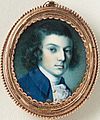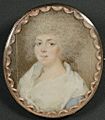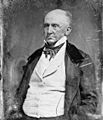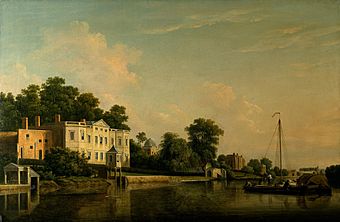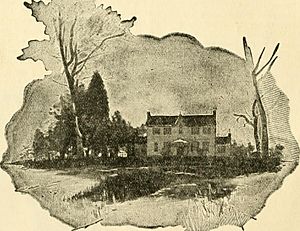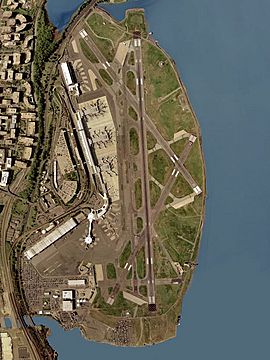Abingdon (plantation) facts for kids
Quick facts for kids Abingdon |
|
|---|---|

Reconstructed Abingdon house foundation (2014)
|
|
| Alternative names | Abingdon Plantation Alexander-Custis Plantation |
| General information | |
| Type | Private residence |
| Architectural style | Georgian |
| Location | Ronald Reagan Washington National Airport, Arlington County, Virginia |
| Country | United States |
| Coordinates | 38°51′05″N 77°02′40″W / 38.851371°N 77.04443938°W |
| Completed | by 1746 (first building) |
| Destroyed | 1930 |
| Owner | Gerard Alexander I Robert Alexander John Parke Custis Dr. David Stuart Walter Alexander General Alexander Hunter Alexander Hunter (2nd) Alfred Richards Brick Company New Washington Brick Company Richmond, Fredericksburg and Potomac Railroad United States government Metropolitan Washington Airports Authority |
Abingdon (also known as the Alexander-Custis Plantation) was a large estate and home from the 1700s and 1800s. Important families like the Alexanders, Custises, Stuarts, and Hunters owned it. Today, the land where Abingdon stood is in Arlington County, Virginia.
Abingdon is famous as the birthplace of Eleanor "Nelly" Parke Custis Lewis. She was born on March 31, 1779. Nelly was the granddaughter of Martha Washington and the step-granddaughter of U.S. President George Washington. People also say that all the weeping willows in the United States came from a tree planted at Abingdon.
Today, Ronald Reagan Washington National Airport covers part of Abingdon's old land. The airport has special displays inside and outside that tell the story of the plantation.
Contents
- History of Abingdon
- Historical Markers at Abingdon Plantation Site
- Abingdon Artifacts in Airport Exhibit Hall
- Location
History of Abingdon
The Alexander Family's Land
The land where Abingdon was built was first given to a shipmaster named Robert Howson in 1669. He received it for bringing settlers to the Colony of Virginia. Howson soon sold the land to John Alexander for 6,000 pounds of tobacco.
John Alexander came from Scotland and settled in Virginia around 1653. He was a farmer, a surveyor, and a captain in the local militia. The land he bought was about 8,000 acres. It stretched along the Potomac River.
After John Alexander died in 1677, his son Robert Alexander inherited the land. In 1735, Robert's grandson, Gerrard Alexander, got the northern part of this large property. By 1746, Gerrard Alexander had a house on this land.
In 1749, the town of Alexandria was started on a southern part of the Alexander family's land. The town was named after John Alexander and his family. In 1761, Gerrard Alexander divided his estate among his sons.
The Custis and Stuart Families
In 1778, John Parke Custis bought Abingdon and its 1,000-acre estate from Robert Alexander. John, often called "Jacky," was the son of Martha Washington and the stepson of George Washington. He really wanted land in the Abingdon area for his family.
However, Jacky was very eager and not very experienced in business. Robert Alexander took advantage of him. The price of £12,000 would grow to over £48,000 because of compound interest over 24 years. When George Washington found out, he told Jacky that most Virginia estates couldn't handle such high interest.
Jacky Custis chose Abingdon because it was halfway between Mount Vernon, the Washingtons' home, and his wife's family home in Maryland. Jacky's wife was Eleanor Calvert. She was a descendant of Cecilius Calvert, an important figure in the founding of the Maryland colony.
In 1778, Jacky Custis was elected to the Virginia General Assembly. Soon after moving to Abingdon, his wife gave birth to their third daughter, Eleanor (Nelly) Parke Custis, on March 31, 1779. Nelly and her siblings grew up at Abingdon.
Sadly, Jacky Custis got sick and died in 1781 during the Battle of Yorktown. After his death, George Washington "adopted" the two youngest Custis children, Nelly and George. They moved to Mount Vernon to live with the Washingtons. The older children stayed at Abingdon.
In 1783, Jacky's widow, Eleanor, married Dr. David Stuart. Dr. Stuart was a friend of George Washington. While living at Abingdon, Dr. Stuart helped plan the new capital city, which became Washington, D.C. He and Eleanor had sixteen children, and at least three were born at Abingdon.
Jacky Custis's finances were a mess when he died. It took over ten years to sort out the Abingdon purchase. The Alexander family sued to get their money back. In 1792, Abingdon was returned to Robert Alexander. After he died, the estate was divided. Walter Alexander got the southern half, which included the Abingdon house.
Over time, different people bought parts of Abingdon. The Wise family lived in the house until "General" Alexander Hunter bought 99 acres, including the house, between 1835 and 1842.
At the same time Jacky Custis bought Abingdon, he also bought another 1,100 acres of land to the north. His son, George Washington Parke Custis, later built Arlington House on this land.
Gallery of the Custis family
-
Mount Vernon Ladies' Association Portrait of John (Jacky) Parke Custis by Charles Willson Peale (around 1774) -
Portrait of Elizabeth (Eliza) Parke Custis by Gilbert Stuart (1796) -
National Gallery of Art Portrait of Eleanor (Nelly) Parke Custis
by Gilbert Stuart (1804) -
Library of Congress George Washington Parke Custis (Daguerreotype by Mathew Brady between 1844 and 1849)
The Weeping Willow Story
A popular story from the 1800s says that John Parke Custis planted the first weeping willow in the United States at Abingdon. The story goes that during the Siege of Boston in 1775-1776, Custis met a British officer. This officer gave Custis a twig from a famous weeping willow tree in England. The tree was planted by the poet Alexander Pope at his home in Twickenham.
The officer had planned to plant the twig himself. But after his army lost, he gave it to Custis instead. Custis then planted the twig at Abingdon. This tree supposedly became the ancestor of all weeping willows in the U.S. at that time.
One such tree was said to grow near Arlington House. Another grew from a piece of the Abingdon willow at General Horatio Gates's farm in New York City. This tree was called "Gates's Willow." However, some writers today question if this story is completely true.
The Hunter Family
"General" Alexander Hunter, a descendant of the Alexander family, bought Abingdon. He had fought in the War of 1812. General Hunter was very rich and spent a lot of money making his house and estate beautiful.
As a U.S. Marshal, Hunter was a friend of President Andrew Jackson. President Jackson often visited Abingdon on Sundays. Hunter had a strict rule: no talking about politics or asking for jobs during Jackson's visits. Besides Jackson, Presidents John Tyler and James K. Polk also visited Abingdon.
A room on the northeast side of the Abingdon house was called "General Washington's room." This was because George Washington often stayed in that room when he visited his stepson, John Parke Custis. General Hunter reportedly said that a house good enough for Washington was good enough for him.
General Hunter died in 1849. He left Abingdon to his brother, Bushrod Washington Hunter, until Bushrod's son, also named Alexander Hunter, grew up. Bushrod Hunter had served in the United States Navy. In 1857, Bushrod Hunter was a pallbearer at the funeral of G.W.P. Custis, who lived nearby at "Arlington Plantation."
The American Civil War
When the American Civil War began in 1861, Bushrod and Alexander Hunter (the younger) left Abingdon to join the Confederate forces. During the war, a New Jersey regiment of the Union Army took over the Abingdon plantation. They called it "Camp Princeton."
In 1864, the U.S. government took control of Abingdon. This happened because the owners failed to pay their taxes in person. The government then sold the property.
Alexander Hunter (the younger) later wrote a book about his Civil War memories. He said that his family left Abingdon in April 1861. He described Abingdon as a "splendid estate" with beautiful trees, orchards, and fine barns. He sadly noted that after the war, "The land was there... but that was all." The house and gardens were destroyed during the war.
After the Civil War
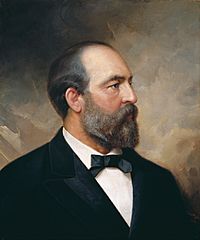
Portrait of James A. Garfield by Ole Peter Hansen Balling (1881)
After the Civil War, Alexander Hunter (the younger) managed to get his land back. The Supreme Court of the United States made this decision on March 21, 1870. James A. Garfield, who later became the 20th President of the United States, was one of Hunter's lawyers.
As payment, Congressman Garfield received 43 acres of Abingdon land. He even planned to build a country home there after becoming president. Garfield's family owned this part of the estate until the 1920s.
Alexander Hunter (the younger) worked for the federal government for 40 years. He also served in the Virginia General Assembly. In 1881, he sold his remaining Abingdon property to the Alfred Richards Brick Company. Today, parts of Abingdon are within Ronald Reagan Washington National Airport and nearby neighborhoods.
Industrial Changes
In 1896, electric trolleys began running next to the old Alexandria Canal, west of Abingdon. By 1902, a tourist booklet described Abingdon as the "birth-place of Nellie Custis." It mentioned the house stood near the Potomac River, a mile from the trolley tracks, beyond a brickyard.
In 1900, the New Washington Brick Company bought the Abingdon property. They used large machines to dig yellow clay from the fields. This clay was used to make bricks for buildings in Washington, D.C. In 1912, a magazine reported that Abingdon was "gradually being eaten away" by the digging.
Even so, the Abingdon house was still in good condition in 1922. It was used as the home for the brick company's superintendent. A child born in the house in 1912 lived there until 1922.
The Abingdon House Design
The Abingdon house in the early 1900s was made of wood in the Georgian style. It was painted white with green shutters and had a shingled roof. Large trees surrounded the house.
In front of the house was a garden that sloped down to the Potomac River. The house's main beams were solid oak, two feet wide. It was two stories tall and had red brick chimneys at each end.
Decline, Fire, and Preservation
In 1922, Lewis Smoot bought the Abingdon House and 158 acres. He moved the boxwood bushes from around the house to his home in Washington, D.C. In 1924, Smoot sold the property to a railroad company. They planned to expand their rail yard onto the land.
From 1923 to 1927, a family leased the Abingdon house and farmed the land. After they left, the railroad company tried to sell or give away parts of the house to make it easier to remove.
By 1928, the Abingdon house was falling apart. Visitors reported that parts of the chimney and a cornerstone had been taken by souvenir hunters. A local historical society asked the railroad to wait before tearing it down, hoping it could be restored. The George Washington Memorial Parkway was built on Abingdon's land between 1929 and 1932.
On March 5, 1930, a fire destroyed the Abingdon house. After the fire, a group called the Association for the Preservation of Virginia Antiquities (now Preservation Virginia) helped stabilize the house's remaining ruins. In 1933, they put up a historical marker at the site.
The Civilian Conservation Corps (CCC) also worked on the Abingdon ruins in the 1930s. They landscaped the area and built a parking lot. They also built a new cover for the old well, trying to match its original design.
For over 50 years, the Abingdon ruins remained mostly untouched. This was true even as Washington National Airport opened in 1941 and expanded around the site.
Metropolitan Washington Airports Authority Takes Over
The U.S. government owned and ran Washington National Airport until 1987. Then, the airport was given to the new Metropolitan Washington Airports Authority under a 50-year lease. This meant the Airports Authority now controlled the Abingdon property.
In 1989, the Airports Authority planned to build a new parking garage where the Abingdon ruins were. To follow historical preservation laws, they studied the history and archaeology of the Abingdon site.
A report in 1991 suggested digging up the site to recover historical information. It also suggested building a museum exhibit in the airport terminal. After this, they planned to build the parking garage.
However, the Airports Authority's plans led to a public effort to save the site. In 1992, the Virginia General Assembly passed a law. It required the Airports Authority to protect and study the Abingdon ruins for one year. During this time, other ways to provide parking without disturbing the site were found.

In 1994, the Airports Authority agreed with Virginia and federal officials to protect the site. They promised to avoid disturbing the archaeological remains during the airport's expansion. They also made a "Preservation Plan" to repair and protect important parts of the site.
In 1998, a contractor for the Airports Authority investigated the site. They preserved and repaired some of the remains. They also moved some artifacts found at the site to a new exhibit hall in the airport's original terminal. A display there says that over 37,000 artifacts have been found at Abingdon since 1988.
The contractor preserved parts of the brick foundations of the Abingdon house and its kitchen. They rebuilt a low foundation over a new concrete base using some original bricks and new materials. When the restoration was finished in 1998, the old ruins were gone. The main foundation looked new, and the well was covered.
Historical Markers at Abingdon Plantation Site
The Abingdon Plantation site at the airport has nine historical markers. They tell the story of the plantation, the families who lived there, and the land itself. Most of these markers were put up by the Airports Authority. The markers are:
- The Ages of Abingdon
- The Alexander Family
- Abingdon and John Alexander
- The Custis Family
- Abingdon Plantation
- The Hunter Family
- The Industrial Age
- Abingdon
- Abingdon Plantation Restoration
Abingdon Artifacts in Airport Exhibit Hall
Terminal A at the airport has an exhibit hall. It displays artifacts found during digs at the Abingdon Plantation site. The displays include:
- Digging Through Layers of Time
- Daily Life: Colonial Times at Abingdon Plantation
- Trade Unites Abingdon with the World
Location
The Abingdon Plantation site is on a small hill between the airport's Parking Garage A and Garage B/C. You can walk to it from either garage. You can also reach it from the south end of the nearby Ronald Reagan Washington National Airport Metrorail station or from the Mount Vernon Bike-Hike Trail.
Historical photographs of Abingdon; List of Arlington Historical Society Magazine articles on Abingdon.


